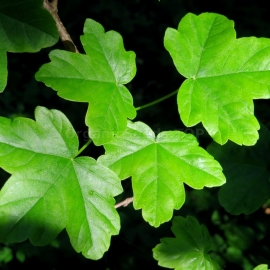




Organic Georgian Maple Seeds (Acer ibericum)
1.14 €
A short, up to 8m, tree with a tent-like crown, gray bark of the trunk and light brown young shoots with numerous whitish lenticels, in which the leaves are 3-lobed, leathery, shiny, glaucous-green and glabrous above.
-
Organic Georgian Maple Seeds (Acer ibericum)
This is a short, up to 8 meters, tree with a tent-shaped crown, gray bark of the trunk and light brown young shoots with numerous whitish lenticels. Leaves are 3-lobed, leathery, shiny, bluish-green and glabrous above; their width exceeds their length. All blades are almost equal in length, all-edged.
In May, along with the leaves, small yellow flowers appear, collected in a few-flowered sessile or drooping shields. In July, the tree is decorated with already ripe drooping tassels of lionfish. They are up to 3.5 centimeters long, directed almost parallel and sometimes touch each other with their wings.
Growing Georgian maple
In nature, it propagates by seeds. In garden culture and park construction, it propagates by seeds, root shoots, "in vitro", garden forms - by grafting. Seeds need stratification at 0-3 ° for 2-3 months. At 5-7 °, its duration increases. Stratification at 0-3 ° can be reduced to 1.5-2.5 months if the seeds are then germinated at 10 °. Isolated embryos start growing slowly and not all. Treatment with stimulants has a positive effect on the seeds - after that, 50-80% of the seeds germinate in 2-3 weeks in the warmth.
Maple Tatar grows slowly, frost-resistant and shade-tolerant, tolerates dryness and salinity of the soil well. It is a good honey plant. Gives honey bees nectar and pollen. Honey productivity up to 100 kg per hectare of solid plantations.
By its morphological properties it is close to the river maple (Acer ginnala), which some botanists consider a subspecies of the Tatar maple A. tataricum subsp. ginnala. They are distinguished, in particular, by the leaves, which are shiny in the riverine maple (matte in the Tatar maple), and the individual blades are clearly expressed and cut much deeper.
Seeds need stratification at 0-3 ° for 2-3 months. At 5-7 °, its duration increases. Stratification at 0-3 ° can be reduced to 1.5-2.5 months if the seeds are then germinated at 10 °. Isolated embryos start growing slowly and not all. Treatment with stimulants has a positive effect on the seeds - after that, 50-80% of the seeds germinate in 2-3 weeks in the warmth.
Maple Tatar grows slowly, frost-resistant and shade-tolerant, tolerates dryness and salinity of the soil well. It is a good honey plant. Gives honey bees nectar and pollen. Honey productivity up to 100 kg per hectare of solid plantations.
By its morphological properties it is close to the river maple (Acer ginnala), which some botanists consider a subspecies of the Tatar maple A. tataricum subsp. ginnala. They are distinguished, in particular, by the leaves, which are shiny in the riverine maple (matte in the Tatar maple), and individual blades are clearly expressed and much deeper indented. The tree is up to 12 m high, 20 cm in diameter with a tent-shaped crown and gray bark.
Young shoots are light brown, glabrous with whitish lenticels. The buds are grayish-light brown glabrous, with cilia along the margin. The leaves are 3-lobed, leathery, glabrous above, shiny, bluish-green, pubescent in youth, later with hairs along the veins, ovoid or triangular, obtuse or pointed, entire or sometimes with two teeth in the upper part. Yellow flowers in scutes appear in May along with leaves.
Lionfish almost parallel or slightly diverging, adjoining or overlapping each other, ripen in July. Begins to bear fruit at the age of 15-20 years. Propagated by seeds, shoots, root suckers. Introduced into culture in the southern regions of the USSR. Photophilous, undemanding to soils, tolerates temperatures up to -22 ° C.
